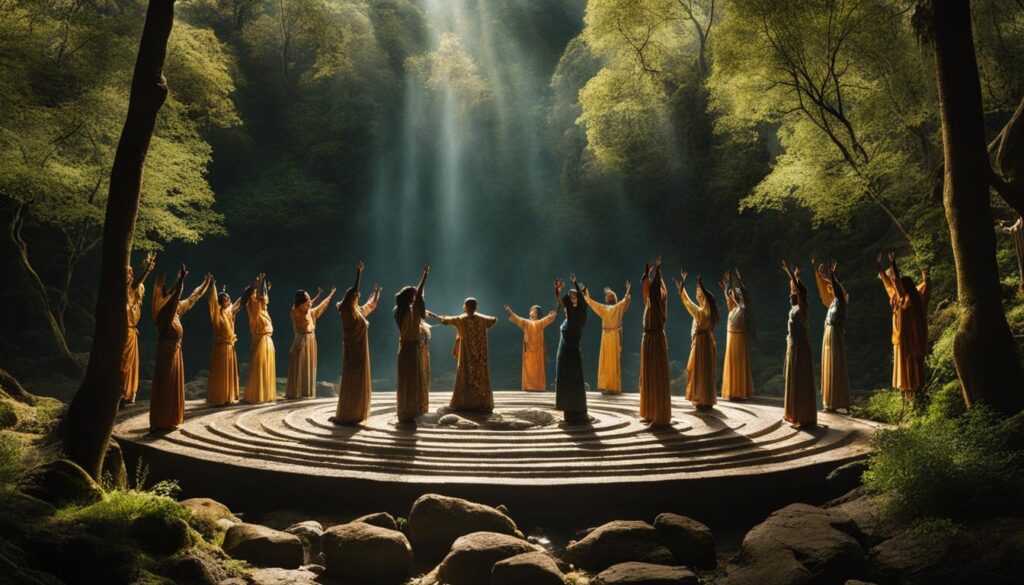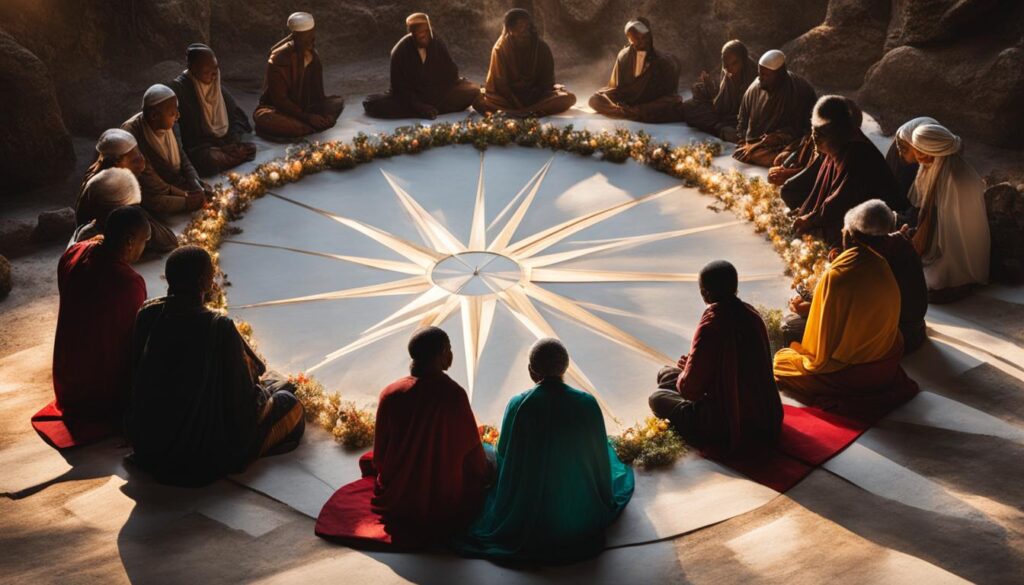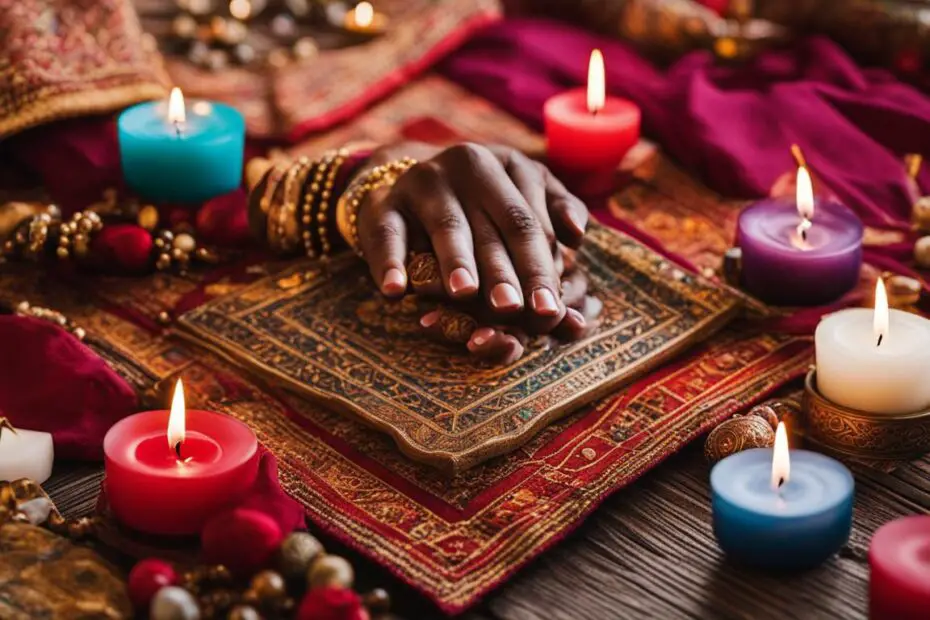Prayer is a fundamental aspect of human life and is practiced in various religions across the world. It is a way for individuals to connect with their higher power and seek guidance, strength, and solace. In this article, we will explore the different prayer practices, rituals, and traditions in major religions such as Islam, Christianity, Judaism, Hinduism, Buddhism, Sikhism, Jainism, Bahá’í Faith, Shintoism, Zoroastrianism, Taoism, and indigenous and tribal religions.
From the five daily prayers in Islam to the Lord’s Prayer in Christianity, prayer takes many forms and holds great significance in each religion. Hinduism embraces prayer as a way to connect with deities through rituals and devotion, while Buddhism focuses on meditation and mindfulness as a form of prayer. Sikhism emphasizes daily prayers to seek union with God, and Jainism emphasizes spiritual purification through recitation of sacred hymns.
Prayer in indigenous and tribal religions often involves a deep connection with nature, spirits, and ancestors, while interfaith prayer aims to promote understanding and unity among people of different faiths.
Throughout this article, we will dive into the prayer practices unique to each religion, shedding light on their rituals, traditions, and spiritual significance. Join us on this journey to explore the diverse world of prayer across religions.
Key Takeaways:
- Prayer is a universal spiritual practice observed in various religions.
- Each religion has its own unique prayer practices, rituals, and traditions.
- Islam, Christianity, Judaism, Hinduism, Buddhism, Sikhism, Jainism, Bahá’í Faith, Shintoism, Zoroastrianism, Taoism, and indigenous and tribal religions all have distinct prayer practices.
- Interfaith prayer promotes understanding and unity among people of different faiths.
- Prayer serves as a means for individuals to connect with their higher power and seek guidance, strength, and solace.
Power of Prayer of Adoration Today
Prayer in Different Religions
| Religion | Deity/Deities/Concept of Prayer | Country with the Largest Population |
|---|---|---|
| Islam | Allah | Indonesia |
| Christianity | God (Holy Trinity) | United States |
| Judaism | Yahweh | Israel |
| Hinduism | Various deities | India |
| Buddhism | Buddha or enlightened beings | China |
| Sikhism | Waheguru (God) | India |
| Jainism | Tirthankaras | India |
| Bahá’í Faith | One God | India |
| Shintoism | Kami (spirits) | Japan |
| Zoroastrianism | Ahura Mazda | Iran |
| Taoism | Tao | China |
| Indigenous and Tribal Religions | Various deities and spirits | Various countries with indigenous populations |
Please note that the information regarding the country with the largest population of a particular faith may vary over time, so it’s always a good idea to verify the most current statistics.
Prayer in Islam
Islam places great importance on prayer, which is known as Salah. Muslims are required to perform five daily prayers at specific times throughout the day. These prayers involve various physical postures and recitations from the Quran. The prayers are performed facing the Kaaba in Mecca and serve as a way for Muslims to commune with Allah and seek his guidance and blessings.
The five daily prayers in Islam are:
- Fajr: The pre-dawn prayer performed before sunrise.
- Dhuhr: The midday prayer performed after the sun has passed its zenith.
- Asr: The afternoon prayer performed in the late afternoon.
- Maghrib: The evening prayer performed immediately after sunset.
- Isha: The night prayer performed after twilight has disappeared.
During the prayers, Muslims engage in specific physical movements called Rak’ahs, which include standing, bowing, prostrating, and sitting. The recitation of specific verses from the Quran is an integral part of the prayers. Muslims strive to maintain purity of mind, body, and soul during the prayer, seeking a deep connection with Allah and submitting to His will. prayer in different religions
Prayer in Islam is not limited to the five daily prayers. Muslims are encouraged to engage in voluntary prayers, such as the Taraweeh prayers during the month of Ramadan, and supplicate to Allah for their personal needs and desires. The act of prayer serves as a constant reminder of the presence of Allah in the lives of Muslims and fosters a sense of spirituality, gratitude, and devotion.
Table: Comparison of Islamic Prayer Customs
| Aspect | Sunni Islam | Shia Islam |
|---|---|---|
| Number of Daily Prayers | Five | Five |
| Prayer Times | Follows the timings prescribed by the Prophet Muhammad | Follows the timings prescribed by the Prophet Muhammad and Ali |
| Recitation in Prayer | Recitation of selected verses from the Quran | Recitation of selected verses from the Quran and additional supplications |
| Importance of Friday Prayer | Considered a congregational prayer with a sermon delivered by an imam | Considered a congregational prayer with a sermon delivered by an imam |
| Pilgrimage | Hajj pilgrimage to Mecca is obligatory once in a lifetime | Hajj pilgrimage to Mecca is obligatory once in a lifetime |
Prayer in Christianity
Prayer holds a significant place in the practice of Christianity. It serves as a way for Christians to establish a deep connection with God, seek guidance, and express their devotion. Christian prayer encompasses both personal and communal forms, allowing believers to engage in a meaningful dialogue with their Creator. religious prayer practices
The Lord’s Prayer, taught by Jesus Christ to his disciples, holds a central position in Christian prayer practices. It is a model prayer that addresses various aspects of human existence, including the acknowledgment of God’s holiness, the desire for His kingdom to come, and the request for daily provision, forgiveness, and protection. The Lord’s Prayer serves as a guide for Christians as they seek to align their hearts and minds with God’s will. prayer traditions
“Our Father, who art in heaven, hallowed be thy name. Thy kingdom come, thy will be done, on earth as it is in heaven. Give us this day our daily bread, and forgive us our trespasses, as we forgive those who trespass against us. And lead us not into temptation, but deliver us from evil. For thine is the kingdom, and the power, and the glory, forever and ever. Amen.”
In addition to the Lord’s Prayer, Christians engage in personal prayer, often seeking solace, strength, guidance, and forgiveness. This form of prayer can take place in any quiet space, whether at home, in a church, or in nature. Communal prayer is also an important aspect of Christianity, where believers come together as a community to lift their voices in worship and seek God’s presence.
Table: Forms of Christian Prayer
| Type of Prayer | Description |
|---|---|
| Personal Prayer | Individual communication with God, expressing personal needs, gratitude, and seeking guidance and forgiveness. |
| Communal Prayer | Gathering of believers in churches or other places of worship to praise God, offer supplications, and seek His presence. |
| Intercessory Prayer | Praying on behalf of others, lifting their needs, concerns, and circumstances before God for His intervention and blessings. |
| Contemplative Prayer | A form of silent prayer, focusing on stillness, meditation, and seeking a deeper connection with God. |
| Prayer of Thanksgiving | Expressing gratitude to God for His blessings, provisions, and answered prayers. |
Christianity embraces prayer as a vital spiritual practice that allows believers to nurture their relationship with God, seek His guidance in their lives, and find strength and solace in His presence.

Prayer in Judaism
Judaism, one of the oldest monotheistic religions, places a significant emphasis on prayer as a way to connect with God and express devotion. Jewish prayer practices are deeply rooted in tradition and encompass both individual and communal worship. One of the central components of Jewish prayer is the recitation of specific prayers, known as tefillah, which are found in the Siddur, the Jewish prayer book. comparative religious prayer
Prayer in Judaism is not limited to specific times or locations, as Jews are encouraged to engage in prayer throughout their daily lives. However, prayer takes on special significance during Shabbat, the holy day of rest and prayer that begins on Friday evening and ends on Saturday evening. During Shabbat, Jews gather in synagogues to participate in communal prayer services, which often include the chanting of sacred texts and the recitation of specific prayers, such as the Amidah.
Along with communal prayer, personal prayer is also an integral part of Jewish worship. Jews are encouraged to develop a personal relationship with God through heartfelt conversations and expressions of gratitude, praise, and supplication. Personal prayer can be performed at any time and place, allowing individuals to connect with God on an individual level and seek guidance and blessings in their daily lives. spiritual practices
Jewish Prayer Practices
Here are some key Jewish prayer practices:
- Shema: The Shema is a central prayer in Judaism, declaring the oneness of God and the love and commitment to Him.
- Tallis and Tefillin: Some Jewish individuals wear a prayer shawl (tallis) and phylacteries (tefillin) during prayer as a symbol of devotion and connection to God.
- Blessings: Jews recite blessings before and after performing various activities, such as eating, drinking, and engaging in daily rituals.
- Yahrzeit: On the anniversary of a loved one’s death, Jews may recite a prayer known as the Kaddish to honor and remember the deceased.
Through prayer, Jews seek to deepen their connection with God, cultivate gratitude, and find spiritual solace and guidance. It is a powerful tool that allows individuals to express their faith and seek a closer relationship with the Divine.
Prayer in Hinduism
Hinduism encompasses a rich tapestry of prayer rituals and devotional expressions. Central to Hindu worship is the practice of puja, a ritualistic offering of prayers to various deities. Hindus may engage in puja at home, visit temples, or participate in community rituals. Devotees often offer flowers, incense, and food to the deities as a sign of reverence and gratitude. prayer in hinduism
A key aspect of Hindu prayer is bhakti, or devotion. Bhakti is expressed through the recitation of sacred songs, chants, and mantras. These devotional practices allow individuals to deepen their connection with the divine and cultivate a sense of spiritual intimacy. Bhakti is a fundamental pathway for Hindus to express their love, surrender, and reverence for the divine.
Table: Hindu Prayer Rituals and Practices
| Prayer Rituals | Description |
|---|---|
| Puja | Ritualistic offering of prayers to deities, often accompanied by the recitation of mantras and the lighting of candles or lamps. |
| Mantras | Sacred sounds or phrases repeated during meditation or prayer to invoke the presence and blessings of specific deities. |
| Bhajans | Devotional songs sung during religious gatherings or at home to express love and devotion to the divine. |
| Aarti | Ceremonial waving of a lit lamp or candle in front of a deity, accompanied by songs and hymns. |
| Yajna | Fire ritual performed to offer prayers to the gods and seek their blessings, often involving the recitation of Vedic hymns. |
Hindu prayer is a deeply personal and customizable practice. It allows individuals to connect with the divine in their own unique way and seek spiritual growth, guidance, and inner transformation. Whether through elaborate ceremonies or simple moments of devotion, Hindu prayer serves as a powerful means of expressing faith, cultivating spiritual awareness, and fostering a deep connection with the divine. prayers for different religions
Prayer in Buddhism
Buddhism, a spiritual tradition originating from the teachings of Siddhartha Gautama, commonly known as the Buddha, has a unique approach to prayer. Instead of seeking external intervention or blessings, Buddhist prayer is primarily a form of meditation and self-reflection. It serves as a means to cultivate mindfulness, compassion, and wisdom, leading to personal enlightenment and liberation from suffering. christianity (including catholicism
Buddhist meditation is central to the prayer practice, with various techniques and methods employed to quiet the mind and develop inner awareness. Mindfulness meditation, focusing on the present moment without judgment, is commonly practiced to deepen concentration and cultivate a deeper understanding of reality. Through meditation, Buddhists aim to attain a state of tranquility, clarity, and insight. protestantism
In addition to meditation, mantras and chanting are also integral to Buddhist prayer. Mantras are sacred sounds or phrases repeated to evoke specific qualities or states of mind. Chanting, the rhythmic recitation of Buddhist scriptures or sutras, is believed to generate positive energy and bring about mental and spiritual transformation. These practices help Buddhists connect with the teachings of the Buddha and cultivate qualities such as compassion, loving-kindness, and equanimity. eastern orthodoxy

The Power of Chanting
“Chanting is the voice of the heart; it is the cry of the soul. It is a powerful tool for inner transformation and awakening.” – Buddhist Master
The act of chanting in Buddhism serves multiple purposes. It not only focuses the mind but also helps in developing concentration and deepening one’s connection with the present moment. The rhythmic repetition of sacred verses or sutras is believed to purify the mind, increase positive energy, and create a harmonious environment for meditation and self-reflection.
Chanting can be performed individually or in a group setting. Buddhist temples often hold chanting sessions where devotees come together to recite sacred texts. This collective chanting creates a sense of unity and shared purpose, fostering a supportive spiritual community.
Mantras for Inner Transformation
In addition to chanting, the use of mantras is a common practice in Buddhist prayer. Mantras are powerful syllables, words, or phrases that are repeated to invoke specific qualities or invite positive energy. They can be recited silently or aloud, depending on the practitioner’s preference.
One of the most widely known mantras in Buddhism is “Om Mani Padme Hum,” which is associated with the bodhisattva of compassion, Avalokiteshvara. This mantra is believed to embody the qualities of compassion, wisdom, and liberation. By reciting the mantra, Buddhists aim to cultivate these qualities within themselves and extend them to all sentient beings.
Summary
In Buddhism, prayer takes the form of meditation, mantras, and chanting. Through these practices, Buddhists seek inner transformation, mindfulness, and insight. Meditation serves as a means to quiet the mind and cultivate awareness, while mantras and chanting help in focusing the mind, purifying thoughts, and generating positive energy. Buddhist prayer is a personal journey towards understanding the nature of reality and finding liberation from suffering.
Prayer in Sikhism
Sikhism, a monotheistic religion founded in the 15th century by Guru Nanak Dev Ji, emphasizes the importance of prayer as a means to connect with the divine. Sikhs believe in the existence of one God, referred to as Waheguru or Akal Purakh, and prayer is seen as a way to seek union with God and live a righteous life. Sikh prayer practices encompass various rituals and devotional acts, including Naam Simran and Ardas.
Naam Simran: Naam Simran, which means the remembrance or repetition of God’s name, is a fundamental aspect of Sikh prayer. It involves reciting or chanting the name of God, such as “Waheguru” or “Satnam,” with deep devotion and focus. Naam Simran is considered a powerful practice that helps individuals connect with the divine presence within themselves and cultivate a sense of inner peace and spiritual awakening.
Ardas: Ardas, meaning supplication or prayer, is a collective prayer recited by Sikhs. It is usually performed in congregation at Gurdwaras (Sikh temples) or during special occasions and ceremonies. Ardas serves as a way for Sikhs to express their gratitude, seek blessings, and offer prayers for the well-being of all. It is a heartfelt plea to Waheguru for guidance, protection, and the welfare of the entire Sikh community and humanity as a whole.
Sikh prayer practices reflect the core values of Sikhism, including equality, justice, and service to others. Sikhs believe that prayer is not merely a ritualistic act but a means to attain spiritual enlightenment and foster a deep connection with the divine. Through the practice of Naam Simran and Ardas, Sikhs seek to align their thoughts, actions, and intentions with the teachings of Guru Nanak and other Sikh Gurus, striving to live a life of compassion, humility, and selfless service.
Table: Comparison of Sikh Prayer Practices
| Prayer Practice | Description |
|---|---|
| Naam Simran | Recitation or chanting of God’s name |
| Ardas | Collective prayer recited for blessings and well-being |
| Nitnem | Recitation of specific prayers and hymns from the Guru Granth Sahib, performed daily |
| Simran | Reflection and meditation on the divine qualities of Waheguru |
| Gurbani Kirtan | Devotional singing of hymns from the Guru Granth Sahib |
In addition to Naam Simran and Ardas, Sikhs also engage in other prayer practices such as Nitnem, Simran, and Gurbani Kirtan. Nitnem refers to the daily recitation of specific prayers and hymns from the Guru Granth Sahib, the Sikh scripture. Simran involves reflecting and meditating on the divine qualities of Waheguru, fostering a sense of spiritual awareness and connection. Gurbani Kirtan, the devotional singing of hymns from the Guru Granth Sahib, is another important aspect of Sikh prayer, allowing individuals to express their love and devotion to God through music and song.
Through these various prayer practices, Sikhs seek to deepen their relationship with Waheguru, embody the teachings of the Sikh Gurus, and live a life of spiritual fulfillment, compassion, and service to humanity.
Prayer in Jainism
Prayer holds great significance in Jainism, a religion that emphasizes non-violence and spiritual purification. Jains engage in various prayer rituals and practices to seek guidance, express devotion, and honor the virtues of the enlightened beings. Two key prayer practices in Jainism are the recitation of the Namokar Mantra and the chanting of sacred scriptures known as Mangal Path.
The Namokar Mantra, also known as the Navakar Mantra, is a fundamental prayer in Jainism. It consists of nine auspicious statements that glorify the qualities of the enlightened beings or Tirthankaras. Jains recite this mantra to pay homage to the spiritual teachers and seek their blessings. The Namokar Mantra acts as a reminder of Jain principles, such as non-violence, truth, and detachment from worldly attachments. Jains consider this mantra as a powerful tool for purifying the mind and attaining spiritual enlightenment.
“Namo Arihantanam, Namo Siddhanam, Namo Ayariyanam, Namo Uvajjhayanam, Namo Loye Savva Sahunam, Eso Panch Namukkaro, Savva Pava Panasano, Mangalanam Cha Savvesim, Padhamam Havai Mangalam”
In addition to the Namokar Mantra, Jains engage in the chanting of scriptures known as Mangal Path. These sacred texts contain teachings and stories of the Tirthankaras and serve as a source of inspiration and guidance for followers. Chanting the Mangal Path is considered a virtuous practice that purifies the mind, cultivates spiritual virtues, and deepens one’s understanding of Jain principles.
Table: Comparing Jain Prayer Rituals
| Prayer Ritual | Description |
|---|---|
| Namokar Mantra | A fundamental prayer consisting of nine auspicious statements that pay homage to the enlightened beings and remind followers of Jain principles. |
| Mangal Path | The chanting of sacred scriptures that contain teachings and stories of the Tirthankaras. It serves as a source of inspiration and guidance for followers. |
| Individual Prayer | Jains engage in personal prayer to seek guidance, express gratitude, and cultivate a deep connection with the divine. |
| Communal Prayer | Jains gather in temples and community spaces to engage in collective prayer, recite scriptures, and participate in rituals. |
Jains believe that prayer is a crucial aspect of their spiritual journey, allowing them to purify their minds, deepen their understanding of Jain principles, and seek spiritual enlightenment.
Prayer in the Bahá’í Faith
The Bahá’í Faith places a significant emphasis on prayer and meditation as integral components of spiritual growth and connection with God. Bahá’ís engage in daily devotional practices, known as Bahá’í devotions, which involve reciting prayers from the Bahá’í scriptures and reflecting on spiritual teachings. These devotions can take place individually in one’s home or in community gatherings.
Prayer in Shintoism
Shintoism, the indigenous religion of Japan, has a rich tradition of prayer and ritual. Shinto prayers, known as Norito, are an essential part of ceremonies and observances in this faith. These prayers are recited by Shinto priests or individuals seeking blessings, protection, and harmony with the kami, the spiritual beings believed to inhabit natural elements and ancestors.
One significant Shinto ritual is known as Omairi, which involves purification rites before approaching a shrine. This ritual typically includes washing hands and mouth to cleanse oneself spiritually before entering the sacred space. Omairi is performed as a sign of respect and reverence for the kami and is an integral part of Shinto prayer practices.

| Shinto Rituals | Description |
|---|---|
| Omairi | Purification rites before approaching a shrine |
| Mikagura | Performing sacred dances and music to honor the kami |
| Norito | Recitation of Shinto prayers by priests or individuals |
Shinto Rituals:
- Omairi: Purification rites before approaching a shrine
- Mikagura: Performing sacred dances and music to honor the kami
- Norito: Recitation of Shinto prayers by priests or individuals
“Shintoism teaches us the importance of being in harmony with nature and the spirits that surround us. Through prayer and ritual, we seek to connect with the kami and find balance in our lives.” – Shinto Priest
The prayers in Shintoism are a way for believers to express their gratitude, seek blessings, and establish a spiritual connection with the divine forces present in the world. The rituals, such as Omairi and Mikagura, serve as a means to honor and communicate with the kami, fostering a deeper understanding and appreciation of the natural world and our place within it.
Prayer in Zoroastrianism
Prayer holds a significant place in the religious practices of Zoroastrianism, one of the oldest known religions in the world. Zoroastrians, also known as Parsis, believe in one Supreme Being called Ahura Mazda, who is believed to be the creator and sustainer of the universe. Prayer serves as a means for Zoroastrians to connect with Ahura Mazda, seek guidance, and express their gratitude and devotion.

The prayers in Zoroastrianism are primarily derived from the Gathas, a collection of hymns attributed to the prophet Zarathustra. These hymns are considered sacred and are recited by Zoroastrians during their prayer rituals. The prayers focus on praising Ahura Mazda, seeking his blessings, and asking for divine guidance in daily life.
Zoroastrian prayer rituals often take place in fire temples, where a sacred fire is kept burning. Fire is considered a symbol of purity and is believed to carry prayers to Ahura Mazda. The prayers are typically performed by priests or individuals, who approach the fire, recite the sacred hymns, and offer their prayers and devotion. Communal prayer gatherings and festivals are also an important part of Zoroastrian worship, where the community comes together to pray and celebrate their faith.
Zoroastrian Prayer Rituals
The Zoroastrian prayer rituals revolve around purity and cleanliness. Before engaging in prayer, individuals must cleanse themselves by washing their hands, face, and feet. They then approach the fire, often facing it, and recite the Gathas or other prayers. The prayers are accompanied by specific physical gestures and postures, which vary depending on the different rituals and occasions.
Prayer in Daily Life
Zoroastrians believe in the importance of prayer in daily life. They strive to maintain a constant connection with Ahura Mazda through personal prayer and reflection. Zoroastrians often recite short prayers, known as Avesta prayers, throughout the day to seek divine guidance and protection.
| Important Prayers in Zoroastrianism | Meaning |
|---|---|
| Ashem Vohu | A prayer for truth, righteousness, and purity. |
| Yatha Ahu Vairyo | A prayer that affirms the power of good thoughts, words, and deeds in the world. |
| Afrinagan | A prayer that blesses and sanctifies various aspects of life, such as water, fire, and food. |
Zoroastrianism teaches that prayer is a powerful tool for spiritual growth and connection with the divine. It allows followers to express their devotion, seek guidance, and foster a deeper understanding of their faith. Through prayer, Zoroastrians strive to lead a righteous life and contribute to the betterment of the world.
Prayer in Taoism
Taoism, a philosophical and religious tradition, encompasses a unique approach to prayer that focuses on spiritual cultivation and harmonizing with the Tao, the ultimate reality. Taoist prayer practices involve meditation, visualization, and the pursuit of inner alchemy to achieve personal transformation and spiritual enlightenment. Rituals and ceremonies are also central to Taoist prayer, such as offerings to deities and the practice of tai chi, a form of moving meditation.
In Taoism, prayer is not about making requests or seeking external intervention, but rather a means of cultivating harmony and aligning oneself with the natural flow of the Tao. Through meditation, Taoists seek to quiet the mind and attain a state of oneness with the universe. Visualization techniques are employed to connect with the spiritual realm and tap into the energy of the Tao. Inner alchemy practices involve working with the body’s energy centers and cultivating virtue to attain spiritual enlightenment.
Tai chi, often referred to as “moving meditation,” is a fundamental practice in Taoism that combines prayerful movements, deep breathing, and focused attention. Practitioners engage in a series of slow, deliberate movements that promote balance, flexibility, and inner peace. Tai chi is not only a physical exercise but also a form of prayer that encourages practitioners to be fully present and attuned to the energy of the Tao.

Prayer in Indigenous and Tribal Religions
In indigenous and tribal religions, prayer is deeply intertwined with the cultural traditions and beliefs of these diverse communities. These religions often emphasize a strong connection with the natural world, spirits, and ancestors. Animism, the belief in the spiritual essence of all things, is a common thread throughout many indigenous and tribal prayer practices.
Prayer in these religions takes various forms, including rituals, ceremonies, and offerings. These practices are aimed at honoring the land, nature, and the spirits believed to govern them. Indigenous and tribal peoples pray to seek blessings, guidance, protection, and harmony with the spiritual forces that surround them.
“The indigenous and tribal communities have a deep respect for the interconnectedness of all beings and view prayer as a way to express gratitude and maintain harmony with the natural world.”
Ancestral worship is also prevalent in many indigenous and tribal religions. People offer prayers and rituals to honor their ancestors, seeking their guidance and blessings in daily life. These practices serve to maintain a strong sense of community, cultural identity, and spiritual connection among these diverse groups.
| Religion | Prayer Practices |
|---|---|
| Native American Spirituality | Smudging ceremonies, vision quests, sweat lodges, honoring the four directions, drumming and chanting ceremonies |
| African Traditional Religions | Offerings, libations, divination, dances, and rituals to connect with ancestors and nature spirits |
| Aboriginal Dreamtime | Storytelling, songlines, rituals, and ceremonies to maintain spiritual connection with the land and ancestors |
| Maori Spirituality | Karakia (chants and prayers) to invoke spiritual protection and guidance, powhiri (ceremonial welcome), and waiata (songs) |
Key Characteristics of Indigenous and Tribal Prayer
- Deep connection with the natural world, spirits, and ancestors
- Animism as a foundational belief
- Rituals and ceremonies to honor the land, nature, and spirits
- Offerings and prayers to seek blessings, guidance, and protection
- Ancestral worship as a means of cultural and spiritual preservation
Overall, prayer in indigenous and tribal religions reflects a profound respect for the interconnectedness of all beings and a recognition of the sacredness in the world around them. These prayer practices serve to nurture the spiritual well-being, cultural identity, and harmonious relationship with the natural and supernatural realms that are central to the lives of these communities.

The Power of Interfaith Prayer
Interfaith prayer is a powerful and transformative practice that brings people from different religious backgrounds together to pray for common goals and intentions. It holds the potential to foster understanding, respect, and unity among individuals of diverse faiths, as they join in collective prayer for the betterment of humanity.
Prayer for unity is at the heart of interfaith prayer gatherings. It serves as a reminder that despite our different beliefs and practices, we are all connected and share a common humanity. Interfaith prayer events provide a safe space for individuals to set aside their differences and come together in a spirit of shared purpose, seeking to create a more harmonious and compassionate world.
Collective prayer has a unique power to transcend religious boundaries and bridge the gaps between various faith traditions. Through interfaith prayer, participants have the opportunity to witness and experience the beauty and wisdom present in different religious practices, deepening their own spiritual understanding and enriching their personal connection with the divine.
Interfaith prayer gatherings often include the sharing of prayers, chants, and rituals from different traditions. This diversity of expressions and experiences creates a rich tapestry of beliefs and practices, allowing participants to broaden their perspectives and gain insights into the different ways people connect with the divine. It cultivates a sense of respect and appreciation for the religious diversity that exists in the world.
By coming together in prayer, individuals from different religious backgrounds actively participate in building bridges of understanding and promoting peace. The collective energy generated through interfaith prayer has the potential to create a ripple effect of positive change, not only within the hearts and minds of the participants but also in the larger community. It serves as a reminder that love, compassion, and unity are universal values that transcend religious boundaries and have the power to transform our world.

Table: Benefits of Interfaith Prayer
| Benefits | Description |
|---|---|
| Unity and Harmony | Interfaith prayer promotes unity and harmony among individuals of different faiths, fostering a sense of shared purpose and respect. |
| Deepened Spiritual Understanding | Participants gain insights into different religious practices, deepening their own spiritual understanding and connection. |
| Broadened Perspectives | Interfaith prayer allows for the sharing of diverse beliefs and practices, broadening perspectives and promoting interreligious dialogue. |
| Positive Social Impact | The collective energy of interfaith prayer can create a ripple effect of positive change, promoting peace and understanding in the larger community. |
| Personal Transformation | Participation in interfaith prayer can lead to personal transformation, fostering a deeper sense of compassion, empathy, and love for all humanity. |
Conclusion
Prayer is a universal spiritual practice that spans across different religions and cultures. It serves as a powerful tool for individuals to connect with their higher power, seek guidance, and express their devotion and gratitude. Through prayer, believers find solace, strength, and a sense of purpose in their spiritual journey.
Each religion has its unique prayer practices, rituals, and traditions. Islam emphasizes the importance of Salah, the five daily prayers, as a way for Muslims to commune with Allah. Christianity encourages personal and communal prayer, with the Lord’s Prayer as a central prayer in the faith. Judaism incorporates prayer into daily life and especially during Shabbat, the holy day of rest and prayer.
Hinduism encompasses a wide range of prayer rituals, including puja and bhakti, as devotees honor and connect with various deities. In Buddhism, prayer takes the form of meditation and mindfulness practices, while Sikhism emphasizes daily prayers, naam simran, and ardas. Jainism focuses on prayer for spiritual purification and liberation from attachments.
The Bahá’í Faith promotes daily devotional practices, obligatory prayers, and reflections on spiritual teachings. Shintoism emphasizes prayers and rituals as a means to seek blessings and harmony with the kami. Zoroastrianism views prayer as a way to connect with Ahura Mazda and includes the recitation of Gathas. Taoism incorporates meditation and inner alchemy practices into its prayer tradition.
Indigenous and tribal religions have diverse prayer practices that honor nature, spirits, and ancestors. These religions often emphasize rituals and ceremonies to seek guidance and express gratitude for the land and its spiritual essence. Interfaith prayer brings together individuals from different faiths, fostering understanding, respect, and unity through collective prayer.
In conclusion, while prayer practices may vary, they all serve as a means for individuals to connect with their higher power, seek spiritual growth, and foster a sense of community. Regardless of religious background, prayer unites believers in their shared pursuit of guidance, blessings, and a deeper connection with the divine.
FAQ
What is prayer?
Prayer is a spiritual practice in which individuals seek connection with their higher power, often through words, meditation, or ritual.
How is prayer practiced in Islam?
Prayer, known as Salah, is an essential aspect of Islam. Muslims are required to perform five daily prayers, facing the Kaaba in Mecca, at specific times throughout the day.
What is the Lord’s Prayer in Christianity?
The Lord’s Prayer is a central prayer in Christianity, taught by Jesus Christ. It is recited by believers as a way to seek guidance, forgiveness, and blessings from God.
When do Jews perform prayers?
Jews perform daily prayers, with a special emphasis on prayer during Shabbat, the holy day of rest and prayer that begins on Friday evening and ends on Saturday evening.
How do Hindus practice prayer?
Hindus practice prayer through puja, which involves offering prayers and rituals to various deities. Worship can take place in temples, homes, or community settings.
What is the role of meditation in Buddhist prayer?
Prayer in Buddhism is primarily a form of meditation and reflection. Buddhists engage in mindful practices, focusing their thoughts and intentions on specific teachings or mantras.
What are the central prayer practices in Sikhism?
Sikhism emphasizes daily prayers, known as Nitnem, which include recitation of specific prayers and hymns. Naam Simran, the repetition of God’s name, and Ardas, a collective prayer, are also significant.
What is the Namokar Mantra in Jainism?
The Namokar Mantra is a fundamental prayer in Jainism, recited by Jains to honor the virtues of the enlightened beings and seek spiritual guidance.
How do Bahá’ís engage in prayer?
Bahá’ís engage in daily devotional practices, reciting prayers from their scriptures and reflecting on spiritual teachings. Obligatory prayers are also an essential part of Bahá’í prayer life.
What are the prayer practices in Shintoism?
Shinto prayers, called Norito, are recited during ceremonies and observances. Shinto rituals often involve purification rites and seeking harmony with nature and ancestral spirits.
How do Zoroastrians practice prayer?
Zoroastrians pray to Ahura Mazda, the Supreme Being, seeking guidance in their daily lives. The Gathas, a collection of hymns, are central prayers in Zoroastrianism.
What are the prayer practices in Taoism?
Taoist prayer involves meditation, visualization, and inner alchemy practices aimed at personal transformation and spiritual enlightenment. Rituals and ceremonies are also common.
How do indigenous and tribal religions practice prayer?
Prayer in indigenous and tribal religions varies, often involving a connection with nature, spirits, and ancestors. Rituals and ceremonies are performed to honor the land and spiritual beings.
What is interfaith prayer?
Interfaith prayer refers to the practice of gathering people from different religious backgrounds to pray together for common goals. It promotes understanding, respect, and unity among people of different faiths.
Why is prayer important across religions?
Prayer is important across religions as it allows believers to seek guidance, express devotion, and connect with their higher power. It helps foster a sense of connection and unity among individuals of different religious backgrounds.








